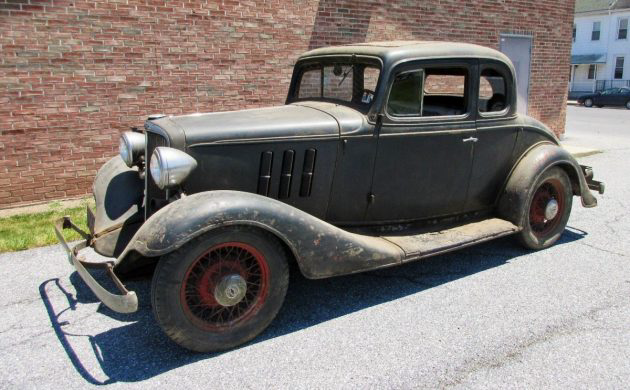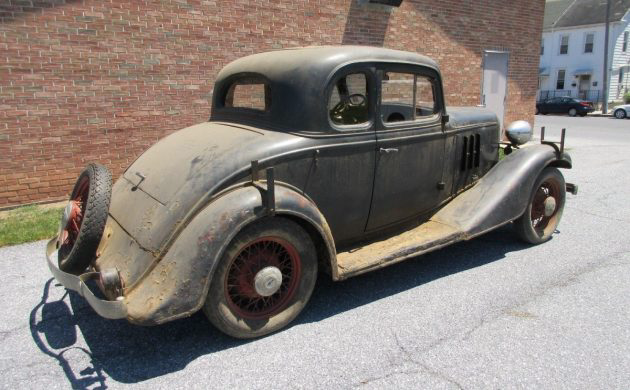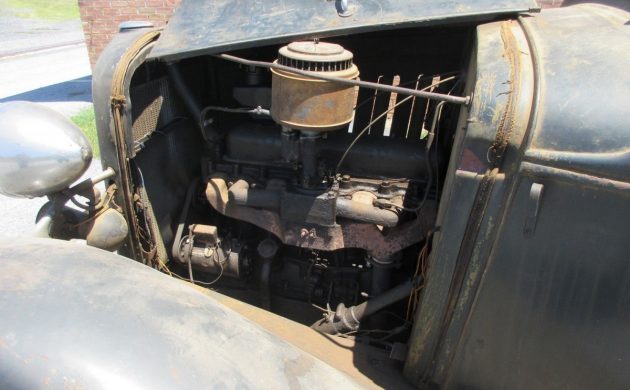Last inspected in 1996, this incredibly original-looking 1933 Chevrolet coupe shows all signs of having been maintained, and repaired, and driven, and never restored. While the Internet has made the discovery of vehicles in such a state seem commonplace, it’s certainly uncanny compared to the great majority that have rusted into near-oblivion or been fussed with for better or worse. Located in Lebanon, Pennsylvania near the classic car (and chocolate) Mecca of Hershey, this dandy Chevrolet seeks a new owner here on eBay. The $21,500 Buy It Now price accompanies a terse listing suggesting the pictures tell the car’s complete story.
Honest-looking and apparently left as it sat for some time, this Chevy hints at 1000 stories from decades of experiences beginning with a shiny first drive. A quick web search yielded no light on the matter, but the fender brackets suggest the once-stylish coupe served some utility, carting about pipes or boards as a substitution for a pickup truck. Comments are welcome on the subject!
The Western Blanket… nature’s way of covering worn upholstery for those who lack the time, skills, or funds to put them right. Holes in the floor, and no doubt elsewhere provide added ventilation.
Chevy’s “Standard Six Coupe” featured, as you may have guessed, an inline six-cylinder engine. Unlike a typical V8 or four-cylinder powerplant, the straight-six is inherently balanced and (all things being equal) makes more torque than a V8 of the same displacement, making the configuration an excellent choice for trucks and luxury vehicles in 1933 and 2018 alike. Do you agree with the seller that $21,500 represents a bargain so obvious that no description of the vehicle is required?











Ifve often wondered why there seems to be so many more fords out there than just about any other brand is it because they just that much better built or were there just way more of them. My dad who is 87 years old now has been a mechanic since the 50’s has told me that it wasn’t un common for a car to come in for an engine rebuild before they had 100k miles on them. The loss of an engine has very often been the end of the road for many cars. Is it possible that Ford cars of this era were just better cars. I’d welcome anyone chiming in. Because there were a lot of cars out there at this time that were just more stylish than a Ford, this car being one of them.
I’d guess Fords were cheaper (lower cost).
The reason why early V8 Fords may have had a higher survival rate is that once in the hands of hot rodders/racers, they were easy and inexpensive to modify compared to, say, a Chevy Stovebolt 6, or any of the flathead sixes/eights from competing makes.
It also may be that those same people moved from Ford four-bangers to the V8s, due to the familiarity with the brand and the bent-eights became more affordable (is there a pun there). As an aside, when the flattie V8s arrived on the Salt (El Mirage and Muroc), owners found that their cars were up to 30 mph SLOWER than the fours, due to the latters’ having had a lot more development over the years.
This Chevy coupe should be either restored or maintained in its current condition, albeit, with its mechanicals sorted out so that it could be safely driven. Mind you, I’m the sort of guy that would consider dropping in a later 235 with some ’50s-era speed equipment, just to piss off the purists and allow the car to easily keep up with traffic. ;-)
One of the reasons there are fewer Chevys as well as other GM cars is the wood used in the bodies. 1937 was the 1st year of the all steel GM bodies. Prior to that wood was used for structure. Doors had sheet metal skins tacked to wooden frameworks etc. Survival rates were less, and repairs were more difficult. Check out the article in this link for a better explanation.
https://www.hotrod.com/articles/0709sr-1933-chevy-coupe/
Looks like a ladder rack on that one side.
I believe these Chevys have wooden frames in the bodywork, while the Fords have steel. So the Fords had a better survival rate.
The reason there are more Fords left is they built 8-10 times more Fords then any other cars. Look up the production figures.
Holy smokes, that ole Chevy’s practically in my backyard. Another ‘un I’d just blow some of the crud off & drive around on the back roads…
I find the above comments interesting and informative and I believe the answer to my question is a combination of all of the above answers. I’ve tried research this but find that the answer is not cut and dry and more digging might yeald a clearer picture. It was my thought that chevy back then was keeping up to fords production numbers I’d personally like a dodge or Plymouth of this era with there near indestructible flat head 6, with its full pressure oiling system. How ever I’d not kick this car out of my garage.
You are correct that it’s a combination, with the exception of the inflated sales number belief. Another factor I didn’t see mentioned that fits with the rest was perceived image. An overly simple way to state it is that a Chevrolet was seen as an old man’s car, a Ford was for the younger, sporty minded. That image prevailed until 1955, and then all hell broke loose………
As to price, to me no, but can see where others will pay.
I worked on a few old chevs, my favorite being 37 -40 coupes and converts.
Lot of youths on east coast would buy these Chevs because they were cheap only to find out the amount of work trying to rod them was no easy task.
I think thesrs 33 had the damn knee action shocks that sucked, and body flex was prevalent and other brands just plain out handled them.
Agree that they were nicely designed, even as sedans, compared to the other majors.
Have to be a labor of love and deep pockets to restore, and whereas well done ones are not in that high a price range I will pass.
I just could never get past not fixing any daily driven auto to be presentable.
A dent needed to be smoothed, a scrape or scratch repainted and not just primered, as owning any auto back then showed others you were an up and coming or had arrived individual.
Driving a rig that looks shabby gave others a dad impression of owners.
Of course those w ran over was bad enpugh but dirty underware made your parents look bad.ere days when children were admonished to wear clean underware in case the got ran over, being
It was the amount of wood in the Chevys that doomed them. Back in 1958 my buddy bought a 32 Chev coupe at the same time I bought my Ford. I was able to chop and channel mine, and because of the amount of expertise required to work the wood in the body, his car turned into a pile of body parts. It was a pity because it was a pretty car.
Bob
At times seeing a car like this finally hit the market at this time in history makes me sad. Without knowing the condition of the body frame work, this otherwise is a very complete and original appearing car. Thirty years ago it might well have fallen into the hands of a capable and motivated restorer. Today, those types are far less in number for this vintage of car. At that price it will not likely find a legitimate buyer, and certainly not someone who will bare the not insignificant cost/effort of full restoration. Not everyone builds/restores for profit, but many don’t want to “throw away” too much either.
As an aside, the lawn equipment fuel tank under the hood is a cute hack.
Epoxy resin can quite often save a wood frame that has some rot. Epoxy is super strong and will hold things together for many years. Using this stuff would definitely minimumize the work need to restore the wood frame and by rapping fibreglass fabric coated with resin at all the joints the over all frame would become much more ridged. It’s the route that I’d go.
I like the epoxy idea also, I have been experimenting with epoxy resin adding chopped fiber and using it as body filler instead of the polyester bondo type of products, It is not for the production shop because of the curing time, but a good way to go for a restoration if strength is needed.
Even to a ford guy this car is very nice! I would love to own it myself!
I am getting tired of this, my Uncle Bob is correct again. Chevrolet out sold Ford in the early 30’s. Chevrolet wood inner structure, 6- cylinder (not fast), old mans car and Ford is just better looking to most people. They were perfect Hot Rods, for their era, just as 55 Chevrolet’s were, for their time!
It is not worth what they are asking for it, after all, it is just an 85-year-old auto parts car. Like every other car sold the minute you take the keys your car becomes used car parts, nowadays the minute you drive it off the lot you have just lost close to $10,000.00 at today’s prices.